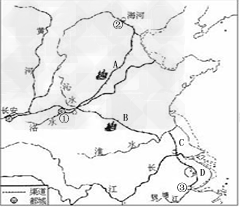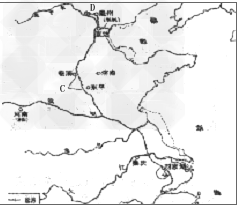观察历史地图:
 | |
| 图(一) |  图(二) |
(1)图(一)为《隋朝大运河》。大运河的中心点①是_________,最北端到达②是_________,最南端到达③是_________。运河A段的名称是___________,B段的名称是_________,开通这条运河的隋朝皇帝是_________。
(1)洛阳;涿郡;余杭;永济渠;通济渠;隋炀帝
(2)会通河;通惠河
(3)相同点:走向基本相同;南北端点相同:北达今北京、南至今杭州;连接的五大水系;都成为贯通中国南北的交通大动脉。不同点:运河的中心不同;隋朝在洛阳,元朝在大都;淮河以北的运河河段有显著变化。
(4)作用:巩固统一多民族国家。促进中国南北方社会经济、文化的交流。
